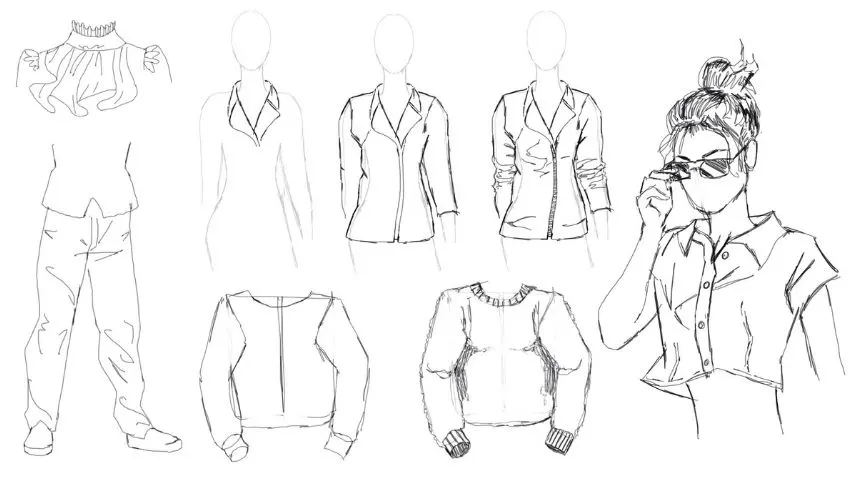When I first drew clothes on a character, it was hard. After knowing some important tips, I understood how to draw folds in clothes.
Once you get a grip on these basics, you are good to go for epic drawings.
My advice would be to always start with the human body, then it becomes a lot easier to draw wrinkles in different types of clothing.
The other tips I am sharing with you will help you draw jeans, sweaters, shirts and know what the key ingredient is to drawing dresses.
Grab your sketch pen, your drawing pad, and hop on with me.
Other related posts to help you draw:
- 10 Tips for Drawing People for Beginners
- 21 Brilliant Tips to Practice Gesture Drawing
- Top 10 Tips to Drawing Backgrounds Like a Pro
Learn the human anatomy in order to draw clothes
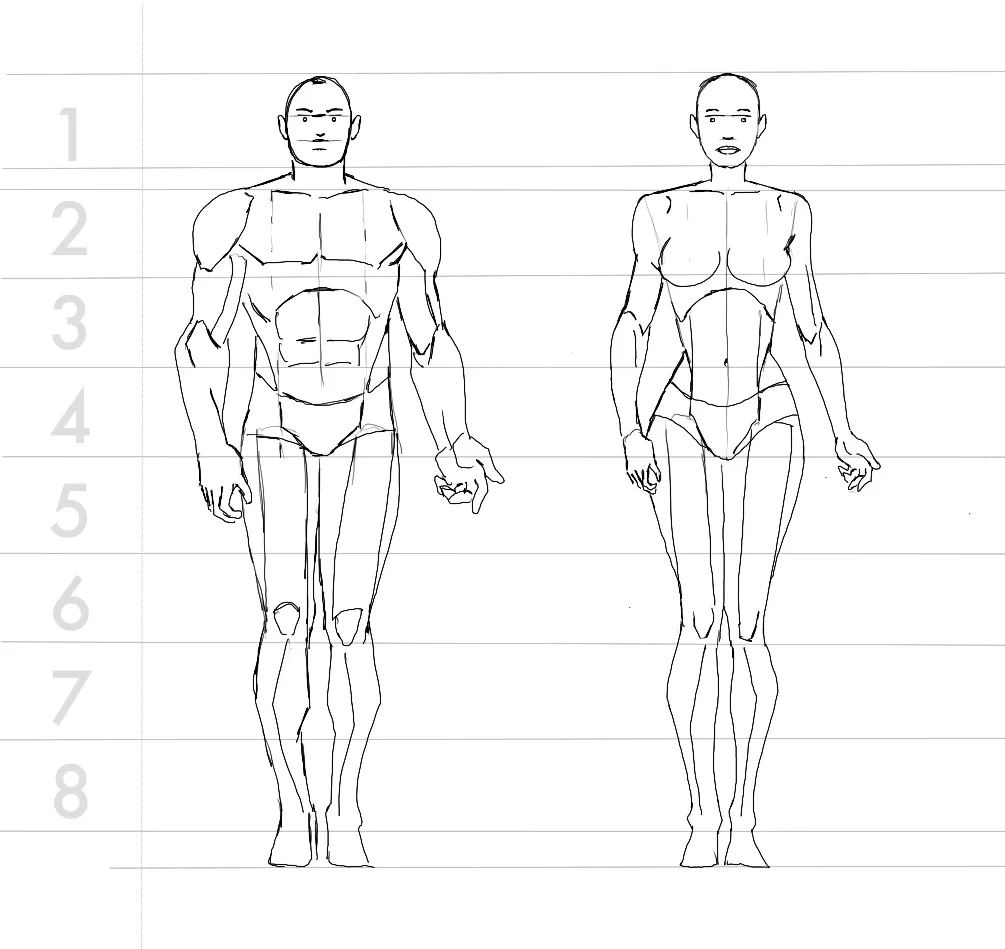
The first and essential tip is to get into the anatomy before drawing clothes.
It is vital to learn deeply about the human body’s anatomy.
Know how to draw a body with its actual shape.
Whether you are drawing from the mind, real-life figure, or reference picture, get the shapes right.
Yes, you might have seen those videos of artists making sketches with unusual bodies.
Indeed, they look so beautiful.
However, they are just sketches in their budding stages.
When it later comes to illustrators, they recreate the drawing with proper bodies with proper proportions.
You can learn anatomy from my free drawing course and/or from these free books on drawing.
Use stylization to help you draw folds
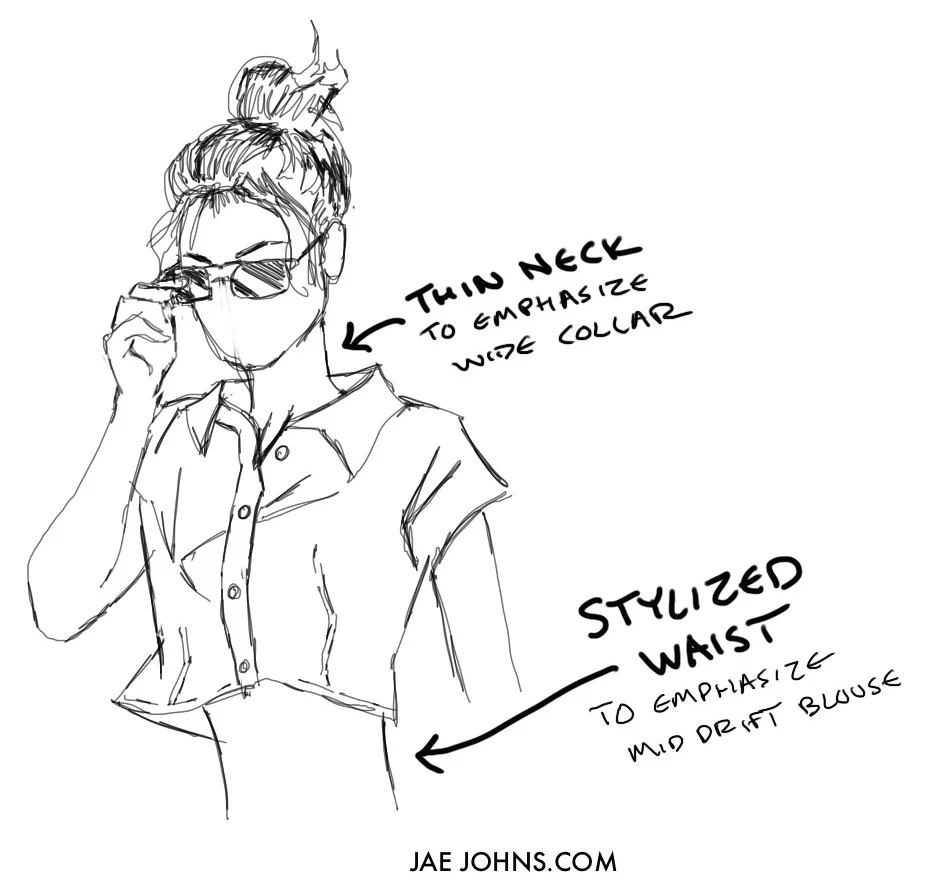
Now, I have an extra tip for drawing clothes.
I recommend you to enhance the clothes’ features in drawing through stylization.
Again, this is a value addition tip.
After you are done with the anatomy, it is time to let your hands float.
Every piece of clothing has some features, which make them stand out.
Features or elements make a drawing what it is.
That is why it is very vital to highlight them through your drawing.
You can stylize your clothes drawing to achieve optimization.
This brings more focus to particular elements of the drawing.
Feel free to exaggerate the facial and figure features in the drawing to accentuate the eminent elements of the drawing.
Make it in a way your drawing stands out.
For instance, you are drawing a figure wearing a ball gown as you know that ball gowns are huge and flow out along the curves.
Now, if you would draw a large waist, the dress would not stand out.
Instead, if you draw a tiny waist, there would be more flow along the curves.
This way your clothes’ design would be more prominent.
Your stylization would tell your story or inspiration behind your drawing.
In the simplest terms, draw the way cartoons are drawn.
Remember Cinderella?
She had a tiny waist to show the outflowing feature of her large wedding gown.
You can know more about stylization in drawing through this video.
Tip on how to draw a jacket
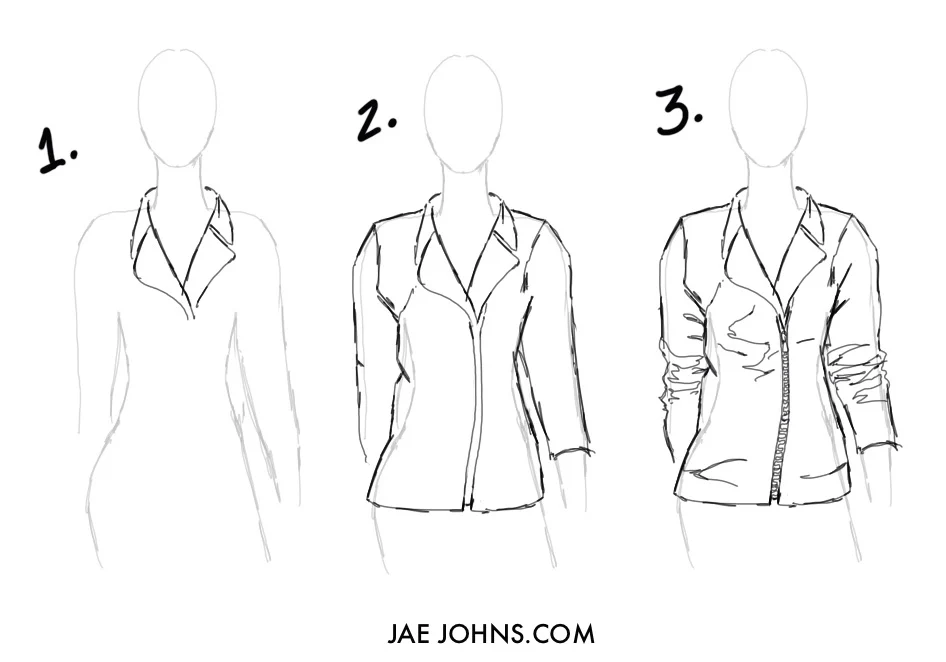
A jacket is one of the basic yet extraordinary clothing items.
It can be worn whether you are at work or even on a red carpet.
That is why artists must know how to draw a jacket.
Now, a jacket can take various cuts, fabrics, and elements.
It is fun to draw it according to your dream design.
However, the most basic design always stands out and is famous in jackets.
Although it is complicated, I would make sure you get it through the most convenient and straightforward way.
Let us get to work.
For this, I would go for a female jacket.
- First, go to my first tip on anatomy. Make sure to draw it on the torso centerline.
- Next up, draw the V-shaped neckline. Start the neckline from the shoulders and end on the button. To enhance this neckline, draw a horizontal V for the collar and lapel. You can experiment with various designs when drawing collars and lapels.
- Next, make the outlines. At this stage, you can experiment with silhouettes and proportions. Make sure not to make it too tight and keep the anatomy in mind.
- Now, draw some folds. This would give the jacket a more defined and realistic look. Draw the wrinkles around the elbow and waist.
You can draw some additional details.
Draw the hems, buttons, emblems, or princess hems.
You can decorate the jacket as you wish.
Remember, this is the most basic way.
You can bring in variations.
Here is a bonus video about jacket drawing.
How to draw sweater folds
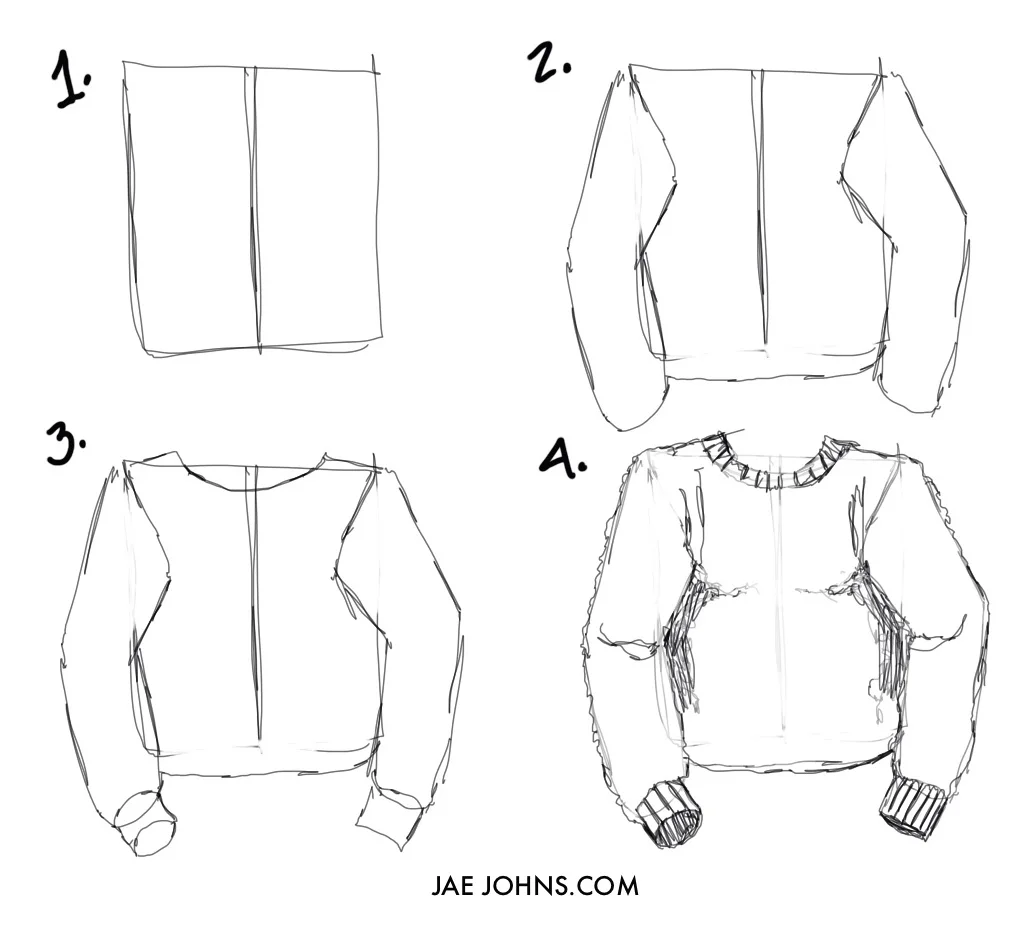
Sweaters are cool and warm.
As an illustrator, learning to draw a sweater is essential as well.
You’ll want to draw a sweater effectively by mastering how to depict the softness and knitting of wool.
This is a bit tricky and needs practice.
However, I am going to share some tips with you.
That would surely help you to get your grip on drawing sweaters.
Sweaters come in all shapes and sizes.
They are varied in patterns and kitting as well.
Let me tell you how to draw a sweater.
Basic sweaters are loose and do not stick to your body.
First, start with the sweater base.
- Start with a rectangular drawing and make a centerline.
- From the top corners of the rectangle, draw two bent lines for the sleeves.
- Next, draw the openings. For this, draw curve lines at the endings of sleeves, hem, and neckline. Add the curve parallels for the ribbing. You can create draw designs on the ribbings as well.
- After all this, draw the sweater outlines. Draw it in an oversized manner. Could you give it a wiggly touch? Make sure that the drawing is not sharp and crisp. Add some wrinkles and folds.
Do not forget to add the knitting details.
After all, they make a sweater.
Make sure the knitting follows the direction of the sleeves.
Add some holes as well.
There you have it—a perfect sweater.
I have a cool sweater drawing video for you here.
Learn the difference of drawing fabrics and texture when drawing clothing folds
Apart from the basic folds, we need to work on an enhanced form of folds, distinguishing between fabrics and textures in a drawing.
Here comes a tip I cannot stress upon much.
This might look hard at a beginner’s stage.
However, if you master the ability to differentiate between fabrics and textures in drawing, you are good to go.
It is when an artist can depict the weight and texture of any material through the drawing.
This shows the attention to detail and mastery to highlight it.
I can tell you that it is tricky and requires a lot of practice.
Now, if the fabric is chiffon, voile, or light silk, you can show it through the straight or airy flowy movement.
Draw a dress that is being blown away from the wind. For a realistic look, color it with light shadings.
Add some white lines.
Make sure to draw wrinkles in the direction of wind and dress blowing.
On the other hand, if the fabric is heavy like velvet, you can depict through a sturdy movement of the figure.
Drawing a fabric largely depends on the position of your figure.
Draw the heavy fabric in a straight and still manner.
For a realistic look, add dark colors. For velvet, double shade the drawing.
On the other hand, you can show a rigid figure for formal suits.
The way it is drawn, how it is draped, or the way it is colored gives an idea about the fabric’s nature.
In addition, you can illustrate the textures in fabrics as well.
Work with color shadowing.
This requires the usage of detailed or sharp pens.
Moreover, it requires practice with an unwavering focus.
Do not forget to smoothen the color.
Through this video, you can learn to practice this technique.
Draw wrinkles at pinch points
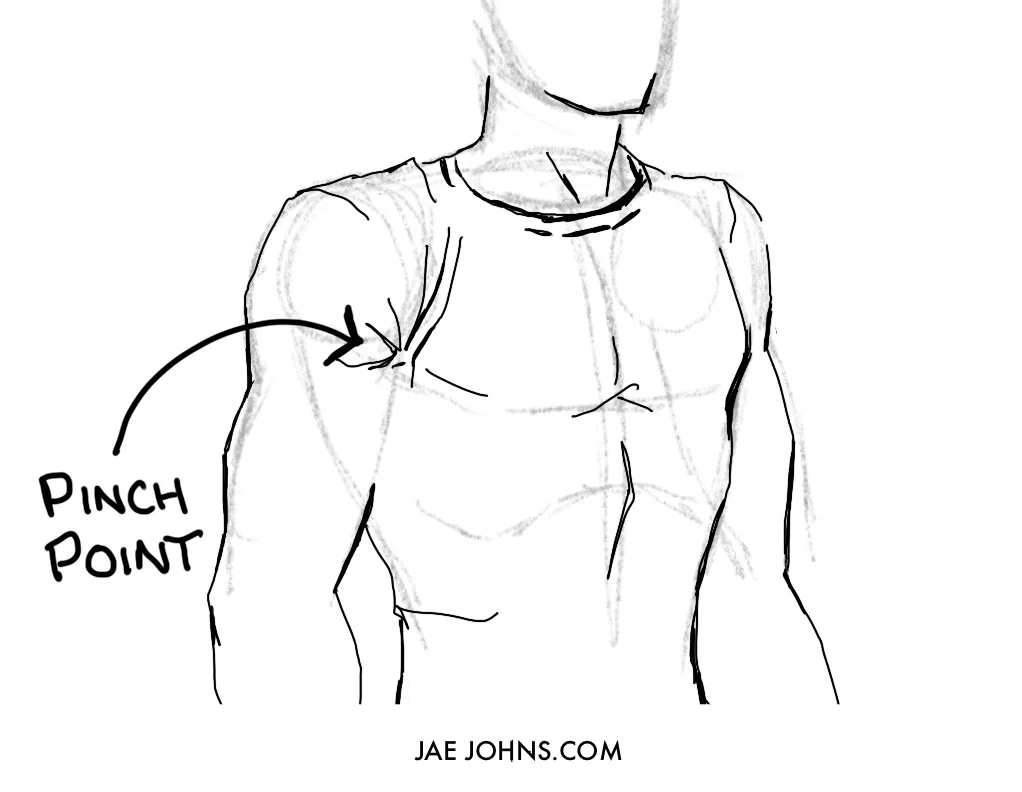
The areas where wrinkles occur are always at pinch points.
Pinch points are areas where the clothing naturally bunches together.
The areas that are pinch points are the following:
- Shoulder
- Armpit
- Elbow
- Crotch
- Knees
Placing wrinkles at the pinch points helps prevent your drawing from looking like it has wrinkles all over the place without any sort of reason to it.
Wrinkles will then radiate outward from the pinch point.
Sketch clothes better by learning where clothing seams are placed
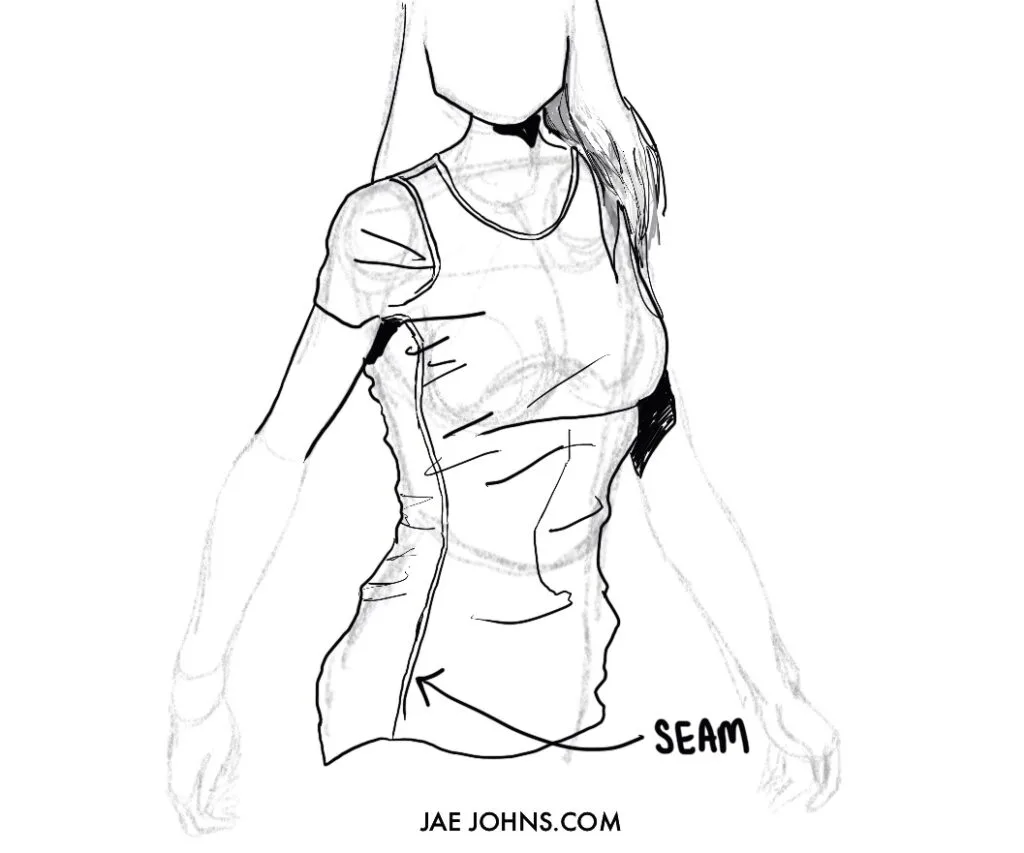
One great tip to sketch clothes is to learn where the seams fall on your clothing.
By learning where seams flow naturally in clothing, it will make your drawings stand out.
It can be extremely easy to know where the seams are.
All you have to do is to look at your shirt or pants.
When you know where to sketch in clothing seams, your folds and wrinkles look realistic.
Seams help show the structure of the form of the body and also add visual interest to the design of the clothing.
Use a pipe fold to draw folds in a dress
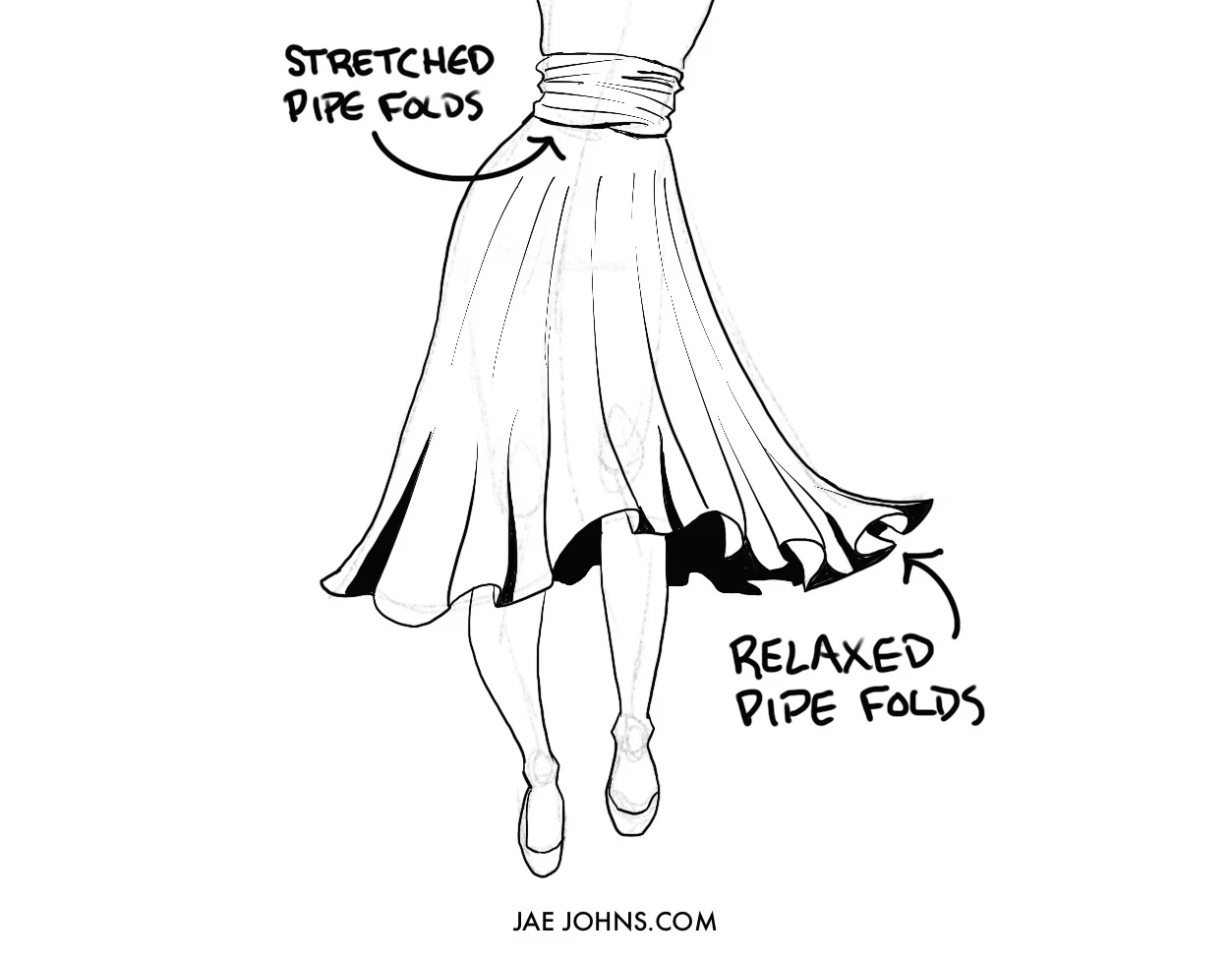
When you draw a dress, the long drapery of the cloth folds a certain way.
The folds tend to be long and cascading and learning how to draw pipe folds will achieve this.
Drawing a dress with a pipe fold is an easy tip a beginner can do that will have instant results.
Pipe folds are a fold that is shaped in a cylinder-like or cone-like appearance.
These types of folds show great depth and volume of clothing, which is perfect for sketching a dress.
Two types of pipe folds:
- Relaxed pipe folds – these type of folds are cylinder like and are very commonly seen on window drapery
- Stretched pipe folds – these are usually thinner and cord-like folds because they are folds that are pulled from one end to the other end.
Tip on how to draw a shirt
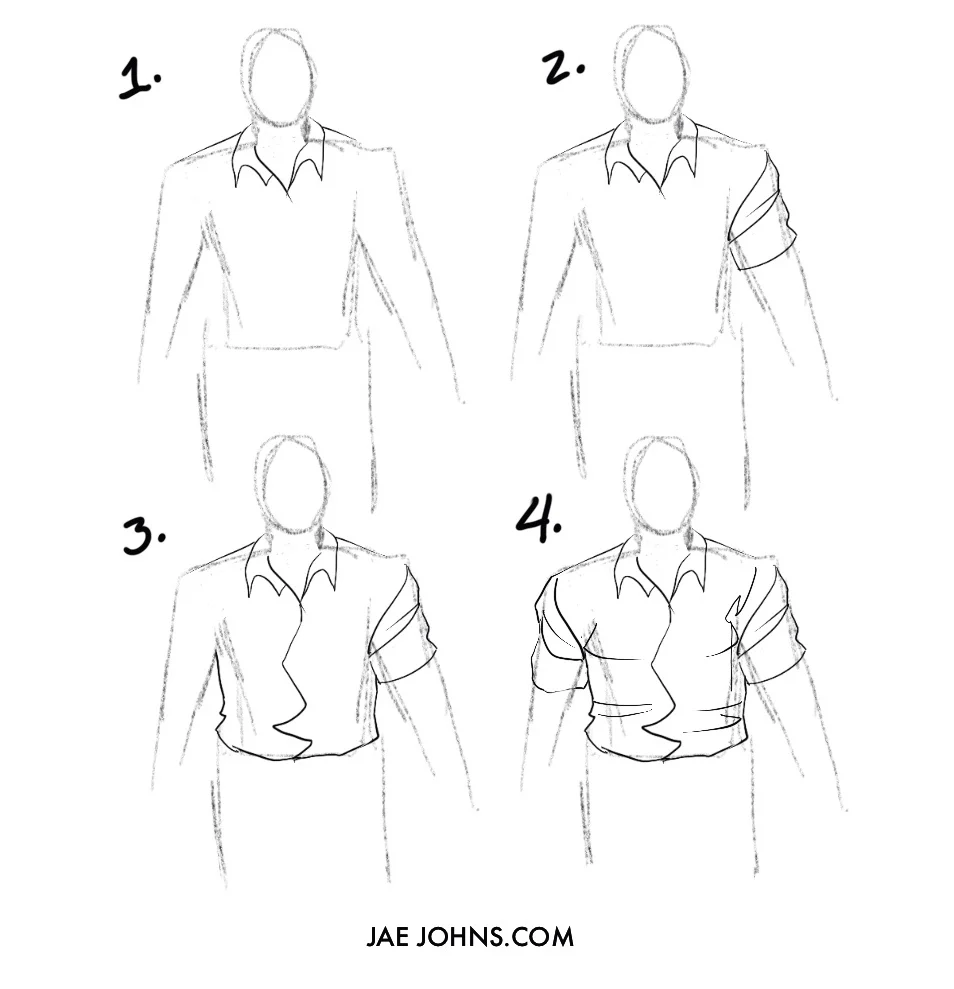
A tip on how to draw shirts is to approximate the folds instead of meticulously drawing each fold or wrinkles like it is in real life.
Sometimes when you try to draw things exactly how they appear in real life, your drawing looks too rigid or stiff.
To approximate folds, you can try to simplify folds as one line.
Here’s how you can draw folds in a shirt:
- Make sure you have a sketch of the anatomy first. Remember that when drawing folds or wrinkles, you want to pay attention to the underlying anatomy.
- Start with the highest point on the shoulder and draw a curve inward to the armpit, next reverse the line outward until you get to around the end of the shoulder muscle, then curve a little bit inward.
- From the center of the collar, draw a line that goes downward then zigzags as it gets to the waist.
- Add in some additional lines for the shirt wrinkles around the abdomen area and below the chest.
Tip on shading the clothes
Shadows and highlighting enhance your clothes drawing.
They give them a more realistic touch.
Shadows around folds vary according to the thickness of the material.
Now when you are drawing folds, you must use a combination of soft and hard edges.
If the clothing were smooth or light, it would reflect more light and give a brighter highlighted outlook.
Make sure to shadow in the dark areas of your drawing.
Through this video, you can learn to shade like a pro.
Tip on drawing pant folds
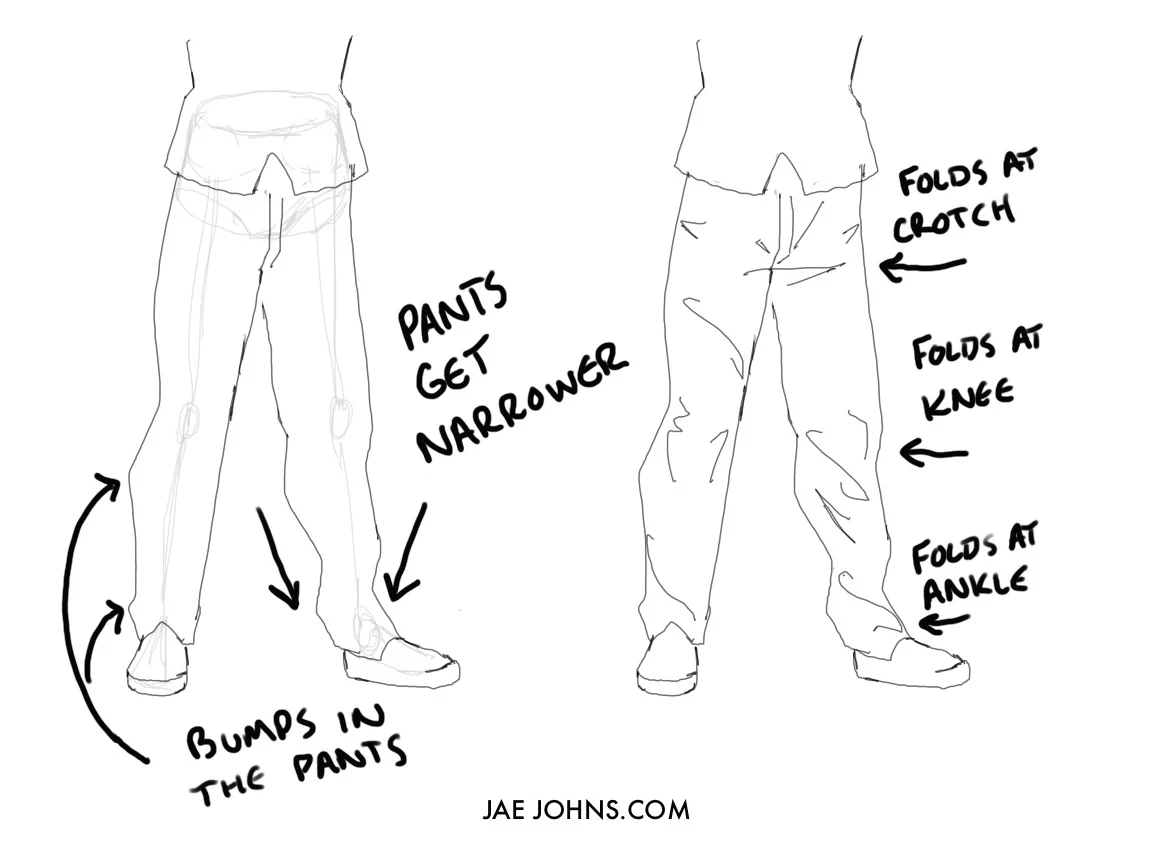
You would have seen different variations of pants.
Without any doubt, they are the essential clothing items and the most stylish ones.
The fabric of the pants is supported at the waist.
When you draw the lower part of the pants, they are narrowed down.
When you are drawing pants, remember to add bumps to pants.
Bumps show their origin and volume. Now, when you are drawing pants from the back, add folds under the hips.
This would also lead to adding folds around the knees.
For a better approach, watch this video.
How to draw baggy clothes tip
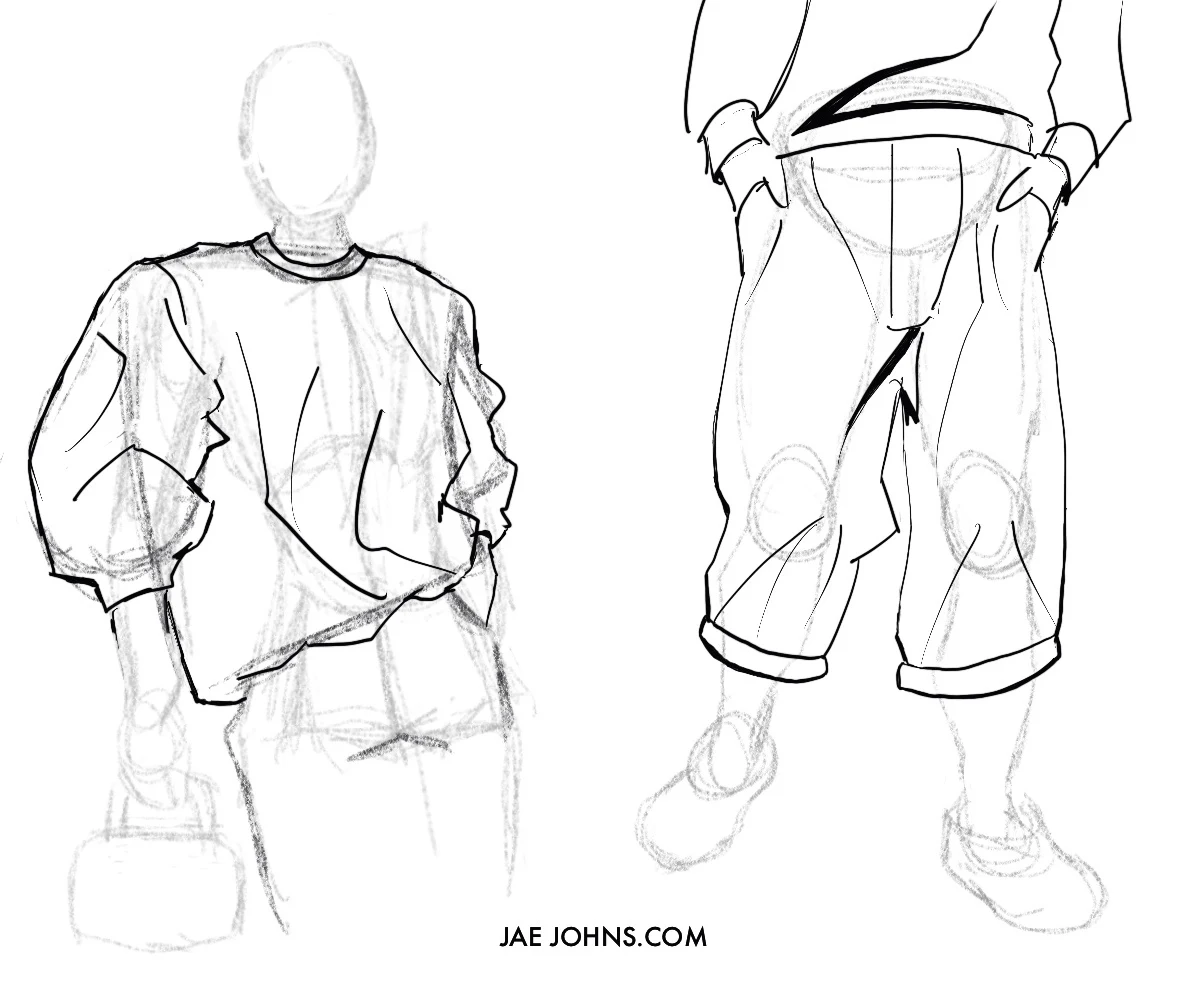
The essential tip on drawing baggy clothes is to think of the basic shape.
There are two basic shapes you need to draw when drawing a baggy shirt or baggy pants.
For the shirt, you will draw a square.
For the pants, you will draw a rectangle.
When drawing a loose shirt or loose pants, it’s important to draw the body of the character first, then draw a square or rectangle that is wider than the volume of the body.
How to draw a baggy shirt
- Like always, start with your anatomy
- Draw a large square for the shirt
- Draw a large football shape with the ends cut off for the sleeves
- Add in some loose wrinkles and folds around pinch points (these are mentioned earlier)
How to draw baggy pants
- Like always, start with your anatomy
- Draw a large rectangle for the jeans or pants
- Normal pants taper as it gets to the ankles, but when you draw loose pants you don’t want to taper them.
- Add in some loose wrinkles and folds around pinch points (these are mentioned earlier)
Tip on drawing ruffles, frills, and folds
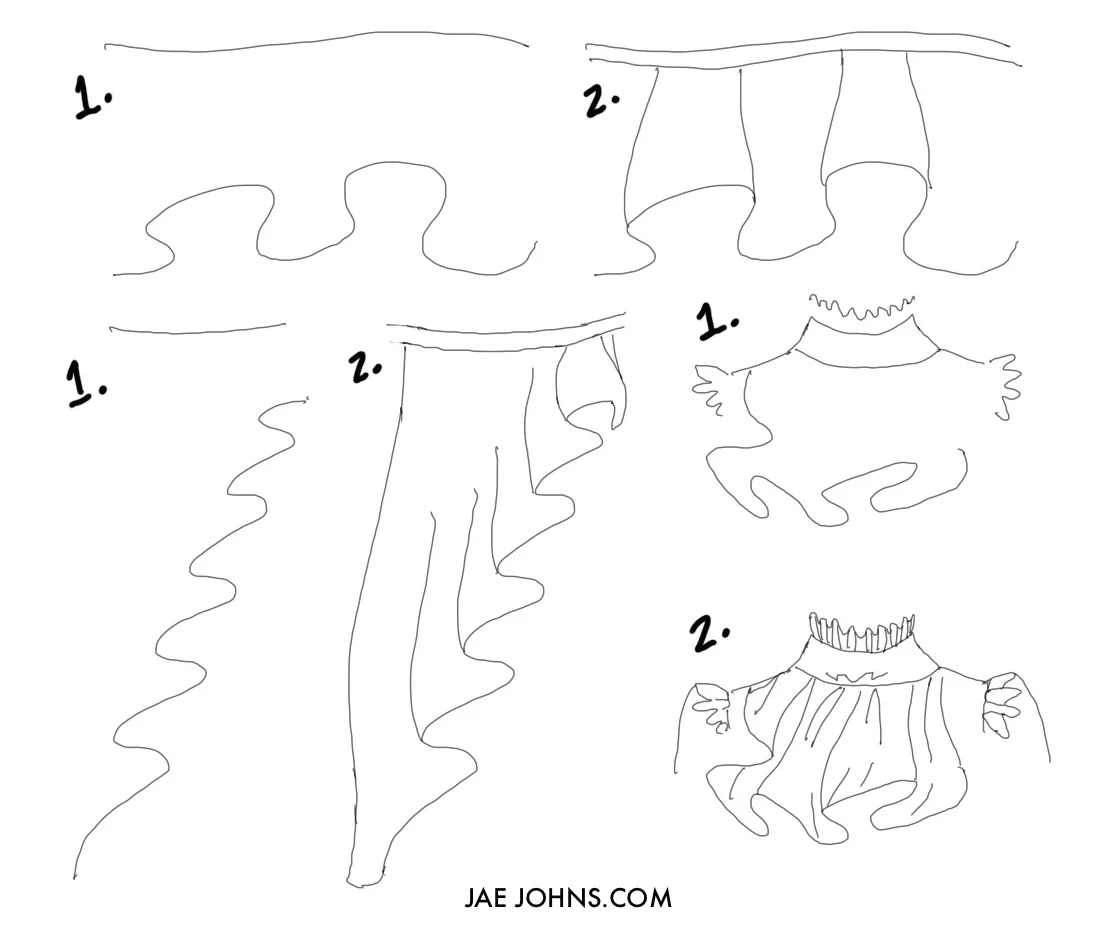
Ruffles, frills, and folds are intricate designs that start with simple drawings.
However, as you start, they become more challenging. You have to keep the cloth structure and fabric movement in mind.
I am going to share my technique that would help you a lot.
- First, draw a curve. Under that curve line, draw a wriggly curve line.
- Add more wriggly lines like a ruffle.
- Add some straight lines for connecting the wriggly lines to the curved line for a frill look.
There you have it—a quick and easy way to draw ruffles.
Here is how you can draw three basic ruffles with this video.
Conclusion
With that being said, I hope you enjoyed learning about 14 pro tips to draw clothes. Good luck to you!

